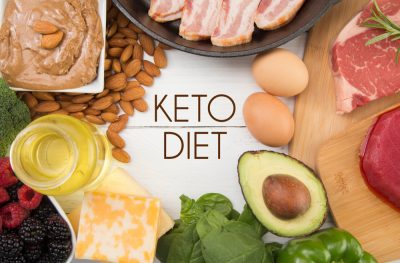The Keto diet or ketogenic diet is popular high in fat yet low in carbohydrates. A typical low-carb diet entails cutting down daily intake to 20% or less. This is roughly equivalent to 100 grams of carbohydrates per day. Committing to a ketogenic diet further raises carbohydrate restriction, ranging between 30 and 50 grams per day.
Following this diet would lead to a metabolic state called ketosis, thus the name of the diet. This is the primary goal that people want to achieve when committing to a keto diet. The stored carbohydrates in the body either serve as fuel for different physiological and physical activities or accumulated in the liver for future purposes. Running out of sugar for fuel triggers the liver in converting fat to ketone bodies which comprise beta-hydroxybutyrate (BHB), acetone, and acetoacetate. Consistent carbohydrate restriction allows the body to produce enough ketone bodies, which will be burned later on as fuel for energy. In this way, the body is forced to burn fat in the absence of glucose.
Regardless of what type of diet one follows, our bodies regularly go in and out of the ketosis metabolic cycle—a consistent keto diet results in a sustained ketosis metabolism.
Achieving Ketosis
 One way of knowing that one has already achieved a nutritional state of ketosis is through a low-cost blood test that uses one of the ketone bodies called BHB. An indicator that the body is in ketosis is when the ketone levels are between 0.5 and 3 mmol per liter. The breath also gives hints whether one is already in ketosis or not. There are breathalyzer tests that determine the levels of ketones in the breath. Another way is based on the quality of smell of the breath. It is common for people in ketosis to experience that their breath has a sweet or fruity scent. For others, one indicator is that the breath gets worse.
One way of knowing that one has already achieved a nutritional state of ketosis is through a low-cost blood test that uses one of the ketone bodies called BHB. An indicator that the body is in ketosis is when the ketone levels are between 0.5 and 3 mmol per liter. The breath also gives hints whether one is already in ketosis or not. There are breathalyzer tests that determine the levels of ketones in the breath. Another way is based on the quality of smell of the breath. It is common for people in ketosis to experience that their breath has a sweet or fruity scent. For others, one indicator is that the breath gets worse.
Before undergoing the keto diet, it is important to know the amount of carbohydrate restriction for beginners. Typically, people initially start with restricting carbohydrate intake to 35 grams or less per day. The usual time it takes before a person enters ketosis happens around one to four weeks.
Gradually cutting down one’s carbohydrate consumption entails increasing the intake of fats. This is now the second phase of the keto diet. There is a need to maintain a 65% to 80% calorie intake from fat. The type of fat incorporated in this regimen is polyunsaturated and monounsaturated fats which is beneficial for the health of the cardiovascular system. On the other hand, trans fats pose a risk to one’s health as it is known as clogging arteries. The good kinds of fat are abundant in lean meats, fatty fish, and dairy products like butter, cheese, and milk. And, compared to carbohydrates, consuming fat curbs the appetite by feeling full within a short period while simultaneously suppressing unnecessary cravings.
Benefits of Keto Diet in Older Adults
The fat to carbohydrates ratio in the keto diet promotes weight management across all age groups, especially for older adults beyond the age of 50. Maintaining weight after losing weight is one of the primary benefits associated with sticking to a keto diet for people aged 50 and beyond. Preliminary researches have discovered the additional health benefits of the keto diet:
- Improving the overall circulatory and cardiovascular health
- Having a better source of energy
- Maintaining stable glucose levels
- Clearer and healthier-looking skin
- Reduces the risk of inflammation and inflammatory diseases like arthritis, Alzheimer’s disease, and heart disease
Can Older Adults do Keto?
 One indicator of a good diet plan lies in the ability of people to sustain this regimen for a long period. The heavily restrictive nature of the keto diet makes it difficult for people to engage in a long-term commitment, possibly months or years. Upon knowing this, it is no surprise why only a few studies focus on long-term randomized trials of this diet, unlike other diet regimens. Scientific studies typically observe diet plans for weeks and even up to years to determine their efficacy. For this matter, there is little to no data regarding the effectiveness of the keto diet in long-term health.
One indicator of a good diet plan lies in the ability of people to sustain this regimen for a long period. The heavily restrictive nature of the keto diet makes it difficult for people to engage in a long-term commitment, possibly months or years. Upon knowing this, it is no surprise why only a few studies focus on long-term randomized trials of this diet, unlike other diet regimens. Scientific studies typically observe diet plans for weeks and even up to years to determine their efficacy. For this matter, there is little to no data regarding the effectiveness of the keto diet in long-term health.
As mentioned earlier, one unpleasant side effect of committing to a keto diet is the noticeable worsening of one’s breath. This persists while a person is still in a state of ketosis. Other side effects typically disappear after a certain period has lapsed—fatigue, low levels of energy, temporary digestive problems, and insomnia are among the most common side effects. These usually occur when the body is undergoing an adjustment period to sudden changes in one’s diet.
Specifically focused on the health of older adults, the keto diet can lead to micronutrient deficiency. Among the many types of micronutrients that older adults are prone to be deficient in are vitamins B12, C, and D, iron, and zinc. Under normal circumstances, micronutrient deficiency can be solved and prevented by consuming different types of fruits and vegetables such as avocados, potatoes, and broccoli. However, the previously mentioned fruits and vegetables contain high levels of carbohydrates which are restricted under a keto diet. A lot of nutrients are missed out by not taking these foods. Thus, consulting with a healthcare professional, preferably a doctor and nutritionist, is recommended before switching to the keto diet.
Keto Diet and Managing Blood Glucose Levels
Emphasizing gradually lowering one’s carbohydrate intake provides better management of blood glucose levels. This is especially advantageous for people who have diabetic hyperglycemia (diabetes characterized by high blood sugar), prediabetes, insulin sensitivity, and those who want to lower the risk of hyperglycemia and overall maintaining one’s health.
The severe restriction of carbohydrates triggers the lower production of insulin responsible for transporting glucose into cells. This makes the keto diet an excellent option for people with insulin resistance problems, which is often a risk factor, particularly in heart-related diseases and diabetes.








COMMENTS